Abstract
The toxicity of misonidazole (1-(2-nitroimidazol-1-yl)-3-methoxy-2-propanol) towards mammalian cells in vitro has been determined as a function of O2 tension. Misonidazole under hypoxic conditions (less than 10 Parts/10(6) O2) shows the greatest toxicity. Split-dose experiments indicate that lethal damage can be "repaired" by O2, the magnitude of this repair being time dependent and a function of O2 concentration, with maximum repair in air seen after 2 h at 37 degree C. Unlike radiation damage this repair is not inhibited by modest hyperthermia (41 degrees C) during the split-dose interval. The implication of these results as regards the mechanism of misonidazole toxicity under anaerobic conditions is discussed.
Full text
PDF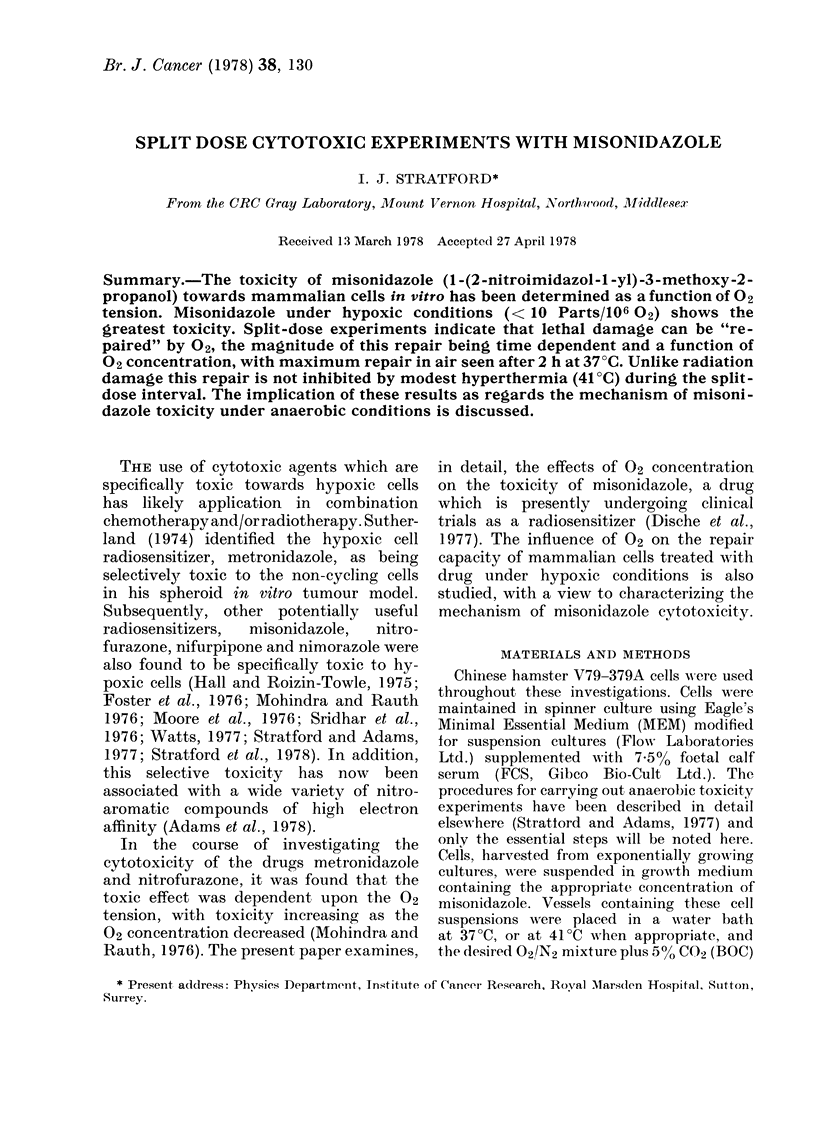

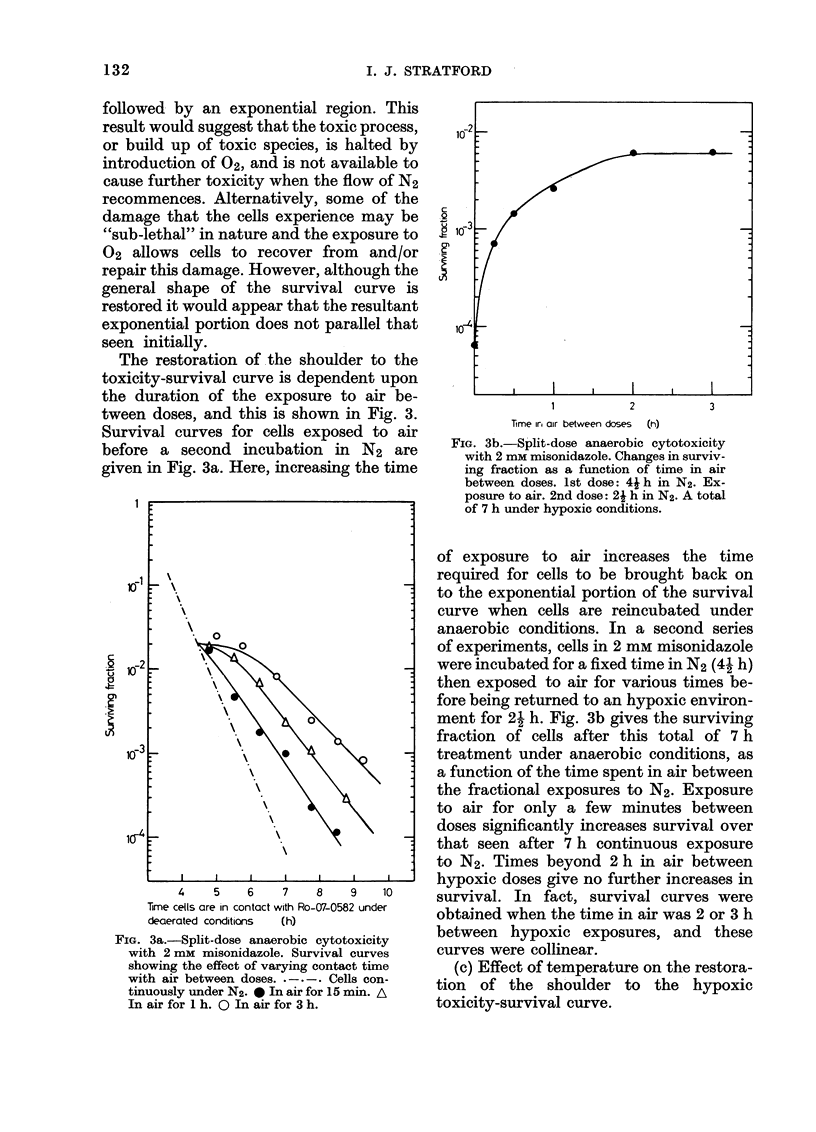
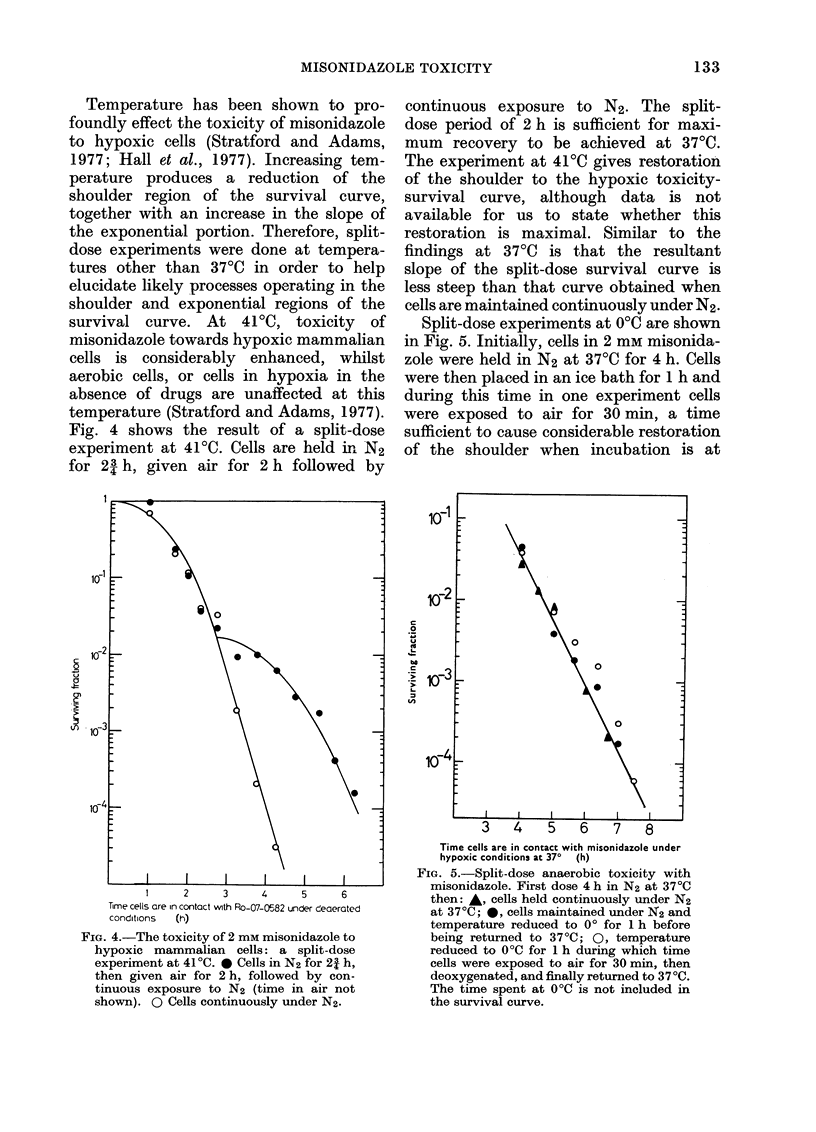
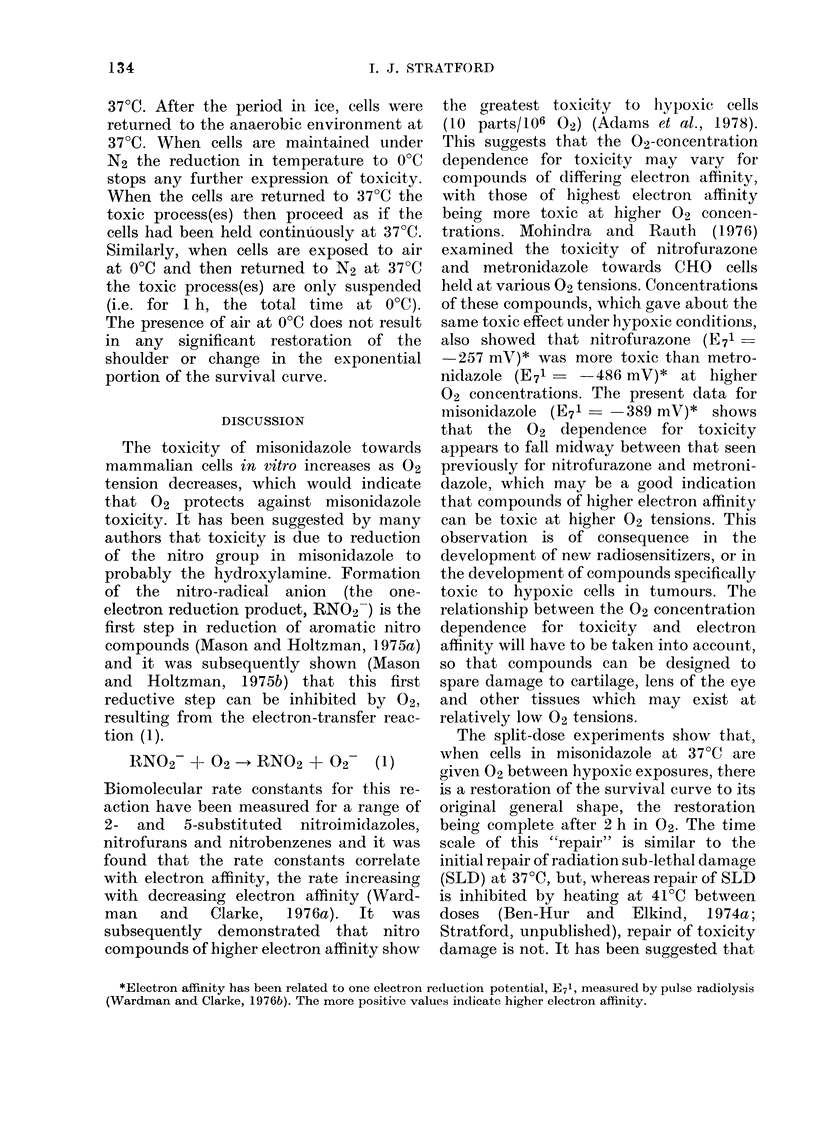
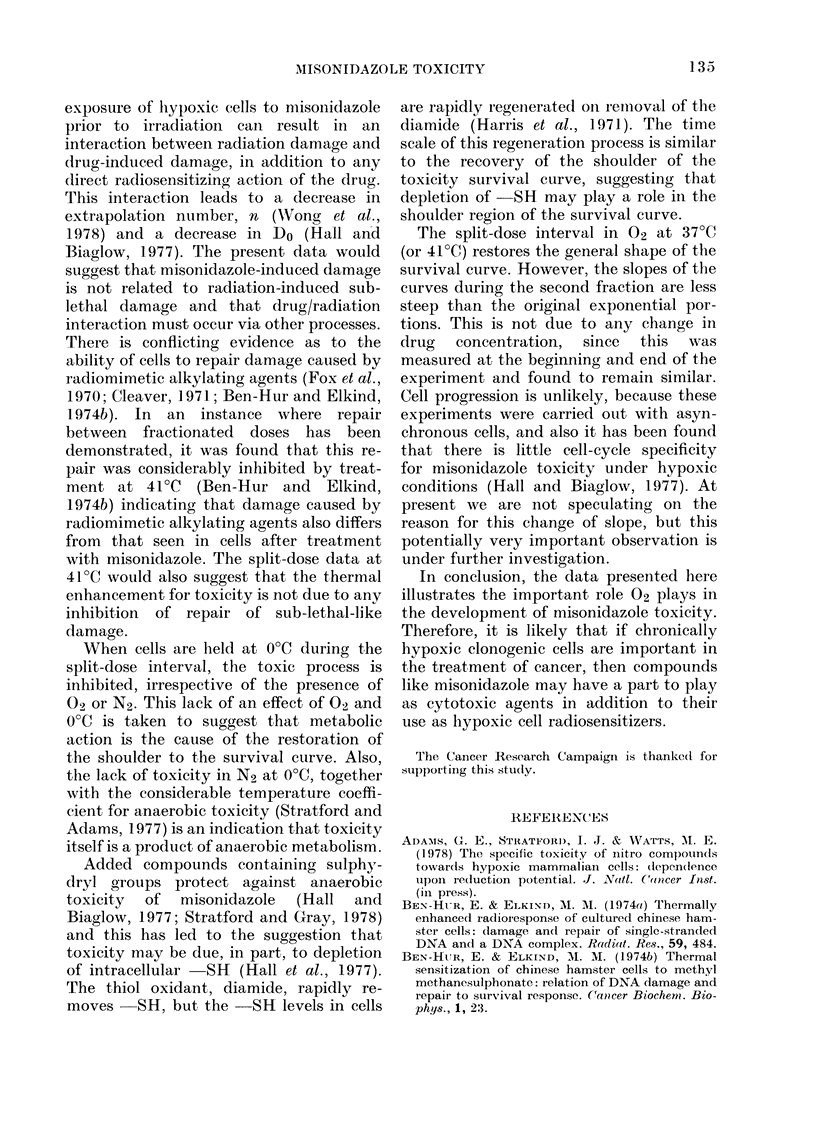
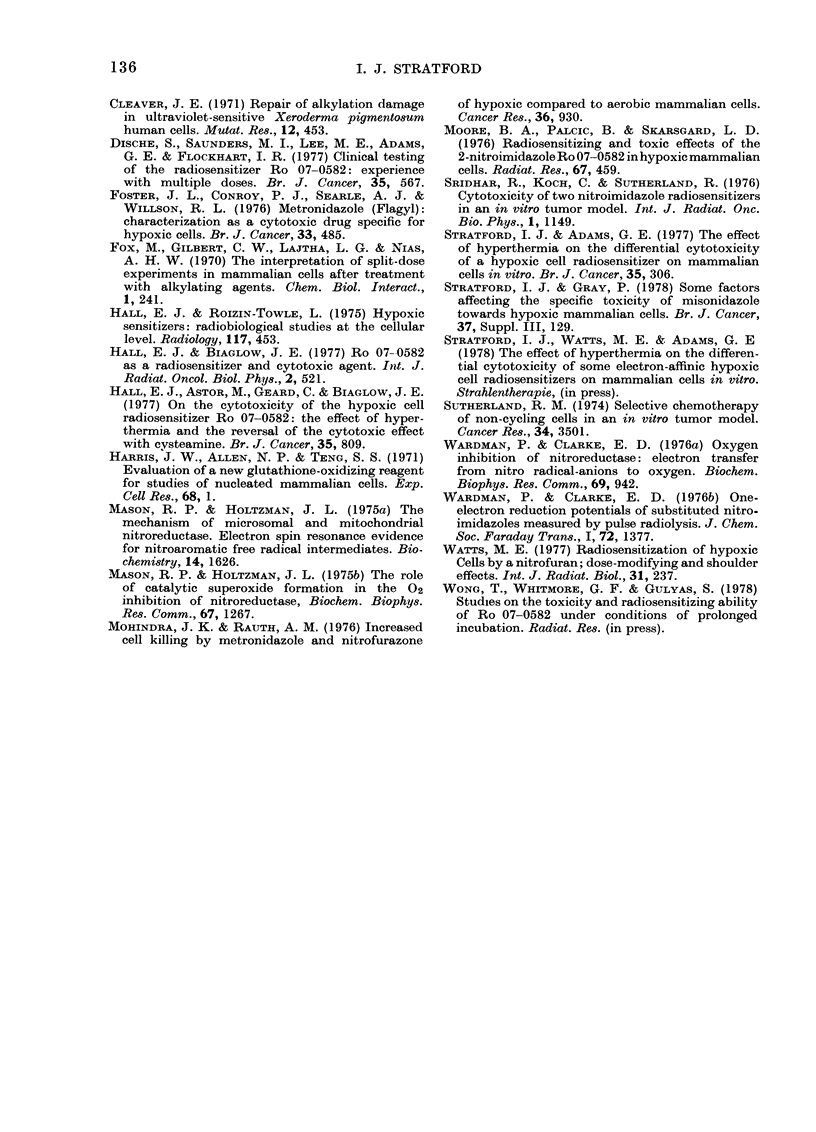
Selected References
These references are in PubMed. This may not be the complete list of references from this article.
- Ben-Hur E., Elkind M. M. Thermally enhanced radioresponse of cultured Chinese hamster cells: damage and repair of single-stranded DNA and a DNA complex. Radiat Res. 1974 Aug;59(2):484–495. [PubMed] [Google Scholar]
- Cleaver J. E. Repair of alkylation damage in ultraviolet-sensitive (xeroderma pigmentosum) human cells. Mutat Res. 1971 Aug;12(4):453–462. doi: 10.1016/0027-5107(71)90095-9. [DOI] [PubMed] [Google Scholar]
- Dische S., Saunders M. I., Lee M. E., Adams G. E., Flockhart I. R. Clinical testing of the radiosensitizer Ro 07-0582: experience with multiple doses. Br J Cancer. 1977 May;35(5):567–579. doi: 10.1038/bjc.1977.90. [DOI] [PMC free article] [PubMed] [Google Scholar]
- Foster J. L., Conroy P. J., Searle A. J., Willson R. L. Metronidazole (Flagyl): characterization as a cytotoxic drug specific for hypoxic tumour cells. Br J Cancer. 1976 May;33(5):485–490. doi: 10.1038/bjc.1976.78. [DOI] [PMC free article] [PubMed] [Google Scholar]
- Fox M., Gilbert C. W., Lajtha L. G., Nias A. H. The interpretation of "split-dose" experiments in mammalian cells after treatment with alkylating agents. Chem Biol Interact. 1970 Feb;1(3):241–246. doi: 10.1016/0009-2797(70)90011-6. [DOI] [PubMed] [Google Scholar]
- Hall E. J., Astor M., Geard C., Biaglow J. Cytotoxicity of Ro-07-0582; enhancement by hyperthermia and protection by cysteamine. Br J Cancer. 1977 Jun;35(6):809–815. doi: 10.1038/bjc.1977.122. [DOI] [PMC free article] [PubMed] [Google Scholar]
- Hall E. J., Biaglow J. Ro-07-0582 as a radiosensitizer and cytotoxic agent. Int J Radiat Oncol Biol Phys. 1977 May-Jun;2(5-6):521–530. doi: 10.1016/0360-3016(77)90163-8. [DOI] [PubMed] [Google Scholar]
- Hall E. J., Roizin-Towle L. Hypoxic sensitizers: radiobiological studies at the cellular level. Radiology. 1975 Nov;117(2):453–457. doi: 10.1148/117.2.453. [DOI] [PubMed] [Google Scholar]
- Harris J. W., Allen N. P., Teng S. S. Evaluation of a new glutathione-oxidizing reagent for studies of nucleated mammalian cells. Exp Cell Res. 1971 Sep;68(1):1–10. doi: 10.1016/0014-4827(71)90579-9. [DOI] [PubMed] [Google Scholar]
- Mason R. P., Holtzman J. L. The mechanism of microsomal and mitochondrial nitroreductase. Electron spin resonance evidence for nitroaromatic free radical intermediates. Biochemistry. 1975 Apr 22;14(8):1626–1632. doi: 10.1021/bi00679a013. [DOI] [PubMed] [Google Scholar]
- Mason R. P., Holtzman J. L. The role of catalytic superoxide formation in the O2 inhibition of nitroreductase. Biochem Biophys Res Commun. 1975 Dec 15;67(4):1267–1274. doi: 10.1016/0006-291x(75)90163-1. [DOI] [PubMed] [Google Scholar]
- Mohindra J. K., Rauth A. M. Increased cell killing by metronidazole and nitrofurazone of hypoxic compared to aerobic mammalian cells. Cancer Res. 1976 Mar;36(3):930–936. [PubMed] [Google Scholar]
- Moore B. A., Palcic B., Skarsgard L. D. Radiosensitizing and toxic effects on the 2-nitroimidazole Ro-07-0582 in hypoxic mammation cells. Radiat Res. 1976 Sep;67(3):459–473. [PubMed] [Google Scholar]
- Sridhar R., Koch C., Suterland R. Cytotoxicity of two nitroimidazole radiosensitizers in an in vitro tumor model. Int J Radiat Oncol Biol Phys. 1976 Nov-Dec;1(11-12):1149–1157. doi: 10.1016/0360-3016(76)90088-2. [DOI] [PubMed] [Google Scholar]
- Stratford I. J., Gray P. Some factors affecting the specific toxicity of misonidazole towards hypoxic mammalian cells. Br J Cancer Suppl. 1978 Jun;3:129–131. [PMC free article] [PubMed] [Google Scholar]
- Sutherland R. M. Selective chemotherapy of noncycling cells in an in vitro tumor model. Cancer Res. 1974 Dec;34(12):3501–3503. [PubMed] [Google Scholar]
- Wardman P., Clarke E. D. Oxygen inhibition of nitroreductase: electron transfer from nitro radical-anions to oxygen. Biochem Biophys Res Commun. 1976 Apr 19;69(4):942–949. doi: 10.1016/0006-291x(76)90464-2. [DOI] [PubMed] [Google Scholar]
- Watts M. E. Radiosensitization of hypoxic cells by a nitrofuran; dose-modifying and shoulder effects. Int J Radiat Biol Relat Stud Phys Chem Med. 1977 Mar;31(3):237–250. doi: 10.1080/09553007714550281. [DOI] [PubMed] [Google Scholar]


